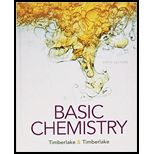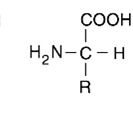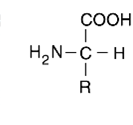
Concept explainers
(a)
Interpretation:
The ionized form of glycine should be drawn.
Concept Introduction:
Amino acids are the building blocks of proteins. Each amino acid when present in ionized form consists of a-carbon that is bonded to ammonium group (NH3+), a hydrogen atom, a carboxylate (-COO-) group and R group. The main difference in the structure of all the 20 amino acids that are present in human body depends on the unique characteristic of R group.
The general structure of R-group is given by:

(b)
Interpretation:
The ionized form of threonine should be drawn.
Concept Introduction:
Amino acids are the building blocks of proteins. Each amino acid when present in ionized form consists of a-carbon that is bonded to ammonium group (NH3+), a hydrogen atom, a carboxylate (-COO-) group and R group. The main difference in the structure of all the 20 amino acids that are present in human body depends on the unique characteristic of R group.
The general structure of R-group is given by:

(c)
Interpretation:
The ionized form of phenylalanine should be drawn.
Concept Introduction:
Amino acids are the building blocks of proteins. Each amino acid when present in ionized form consists of a-carbon that is bonded to ammonium group (NH3+), a hydrogen atom, a carboxylate (-COO-) group and R group. The main difference in the structure of all the 20 amino acids that are present in human body depends on the unique characteristic of R group.
The general structure of R-group is given by:

Want to see the full answer?
Check out a sample textbook solution
Chapter 18 Solutions
Basic Chemistry - With Access
 ChemistryChemistryISBN:9781305957404Author:Steven S. Zumdahl, Susan A. Zumdahl, Donald J. DeCostePublisher:Cengage Learning
ChemistryChemistryISBN:9781305957404Author:Steven S. Zumdahl, Susan A. Zumdahl, Donald J. DeCostePublisher:Cengage Learning ChemistryChemistryISBN:9781259911156Author:Raymond Chang Dr., Jason Overby ProfessorPublisher:McGraw-Hill Education
ChemistryChemistryISBN:9781259911156Author:Raymond Chang Dr., Jason Overby ProfessorPublisher:McGraw-Hill Education Principles of Instrumental AnalysisChemistryISBN:9781305577213Author:Douglas A. Skoog, F. James Holler, Stanley R. CrouchPublisher:Cengage Learning
Principles of Instrumental AnalysisChemistryISBN:9781305577213Author:Douglas A. Skoog, F. James Holler, Stanley R. CrouchPublisher:Cengage Learning Organic ChemistryChemistryISBN:9780078021558Author:Janice Gorzynski Smith Dr.Publisher:McGraw-Hill Education
Organic ChemistryChemistryISBN:9780078021558Author:Janice Gorzynski Smith Dr.Publisher:McGraw-Hill Education Chemistry: Principles and ReactionsChemistryISBN:9781305079373Author:William L. Masterton, Cecile N. HurleyPublisher:Cengage Learning
Chemistry: Principles and ReactionsChemistryISBN:9781305079373Author:William L. Masterton, Cecile N. HurleyPublisher:Cengage Learning Elementary Principles of Chemical Processes, Bind...ChemistryISBN:9781118431221Author:Richard M. Felder, Ronald W. Rousseau, Lisa G. BullardPublisher:WILEY
Elementary Principles of Chemical Processes, Bind...ChemistryISBN:9781118431221Author:Richard M. Felder, Ronald W. Rousseau, Lisa G. BullardPublisher:WILEY





